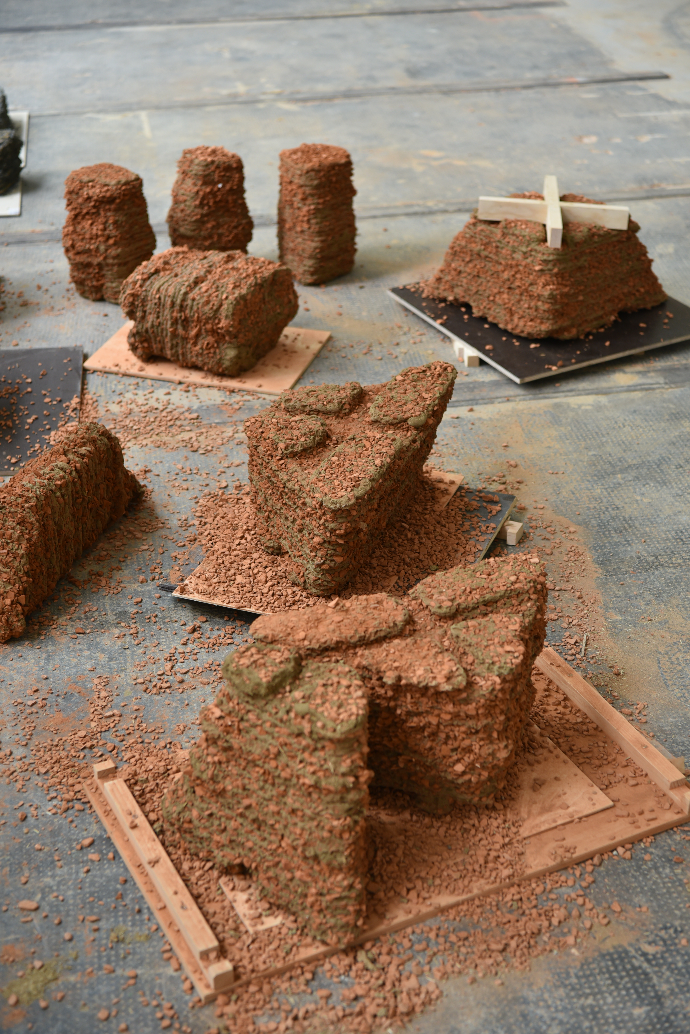Research Summary Report of A10
Earth Additive Manufacturing (EAM) – Material and Process Combinations for AM with Earth-based Materials
[29.11.2024]
M. A. Ema Krakovská Researcher, ema.krakovska@tum.de
Prof. Dr. Kathrin Dörfler Project leader, doerfler@tum.de
all: TU Munich (TUM), Professorship of Digital Fabrication
The main research objective of A10 is the conception and investigation of two novel Earth Additive Manufacturing (EAM) processes, their material-process interactions, and their evaluation in large-scale architectural applications. Focusing on the characterisation of earth-based material mixtures (PL Machner), the project investigates a) Sprayed Earth Additive Manufacturing (SEAM) as a deposition-based process (PL Kloft) and b) Intrusion Earth Additive Manufacturing (IEAM) as a particle-bed-based process (PL Dörfler). The research aims to assess earth-based materials for these processes with a focus on pumpability, buildability, shrinkage, and strength. It seeks to develop the two processes with varied material combinations. Additionally, the research explores these technologies for architectural components combining insulation and load transfer, validated through full-scale fabrication experiments and demonstrators.
Summary
This report overviews ongoing research into the novel particle-bed fabrication technique with earthen materials titled Intrusion Earth Additive Manufacturing (IEAM). IEAM employs a robotically extruded earth paste consisting of clay, sand, straw fibres, and water, to act as the binder in an aggregate bed composed of recycled bricks. The earth binder is applied directly on the aggregate bed (Fig. 1b) and, depending on its viscosity, either partially sinks into the aggregates or remains fully on the surface. Following the application of the earth binder, a layer of aggregates is uniformly distributed in the particle bed (Fig. 1c) and pressed into the binder for compaction (Fig. 1d) before the next layer is applied. The method is being developed concurrently from three perspectives: material, process, and application, embedded in the interdisciplinary research framework of PL Dörfler with PL Machner and PL Kloft.
Firstly, the research focuses on defining fundamental material properties, including the composition of earth-binder mixtures, their rheological behaviour, and the characteristics of the particle bed, such as aggregate grain size distribution. the reciprocal dependencies of material- and process properties with respect to mixing, conveying, and intrusion of earth paste into a particle bed of aggregates are examined. Generally, the aim is to reduce the use of mixing water to a minimum to reduce shrinking and drying time and increase green strength. This objective requires conducting parameter studies on optimal material mixtures and plasticity values of the earth paste for the processing phase, as well as studies on ideal particle sizes and distributions. Secondly, it involves examining process parameters and developing a fully automated fabrication setup to ensure consistent and comparable results. Finally, the project explores the method’s potential building applications, exploring the architectural design possibilities enabled by IEAM.
Current state of research
To comprehensively address the material, process, and application aspects of IEAM, an architectural design studio titled 3D Printing Earth Architecture was conducted during the summer semester of 2024 at the Technical University of Munich. This studio explored the IEAM fabrication method as a key driver in building design and construction. Initial material and manual fabrication studies formed the foundation for developing preliminary design ideas at the component and assembly levels. These concepts were then synthesised into the design of small pavilion structures, exploring compression-appropriate construction, component prefabrication, interlocking joints, and on-site assembly.
The design proposals showcased various construction strategies enabled by the IEAM method. One selected approach features a dome-like design with 3D components employing notch joints for assembly and structure (Fig. 2a). In a second approach, a pavilion structure with a funicular shape is segmented into components based on principal stresses (Fig. 2b). Lastly, a hybrid design explores combining timber and earth for assembly and transportation, while also incorporating post-tensioning cables (Fig. 2c).
To experimentally evaluate the design proposals’ manufacturability, sections of the designed structures were 3D-printed at a 1:4 scale (Fig. 3) using a semi-automated IEAM setup. The gradual buildup of the particle-bed formwork, the aggregate deposition and the mechanical compaction procedure were performed manually. The intrusion of the earth binder was taken on by a UR10e robot with a custom-built end-effector connected to a rotary pump.

Figure 1: EAM process steps: a) compacted layer; b) earth binder intrusion; c) aggregate deposition; d) mechanical compaction

Figure 2: Selected results from the architectural design studio 3D Printing Earth Architecture / Credit: Ema Krakovská
Fabrication process of Intrusion Earth Additive Manufacturing (IEAM) / Credit: Ema Krakovská







